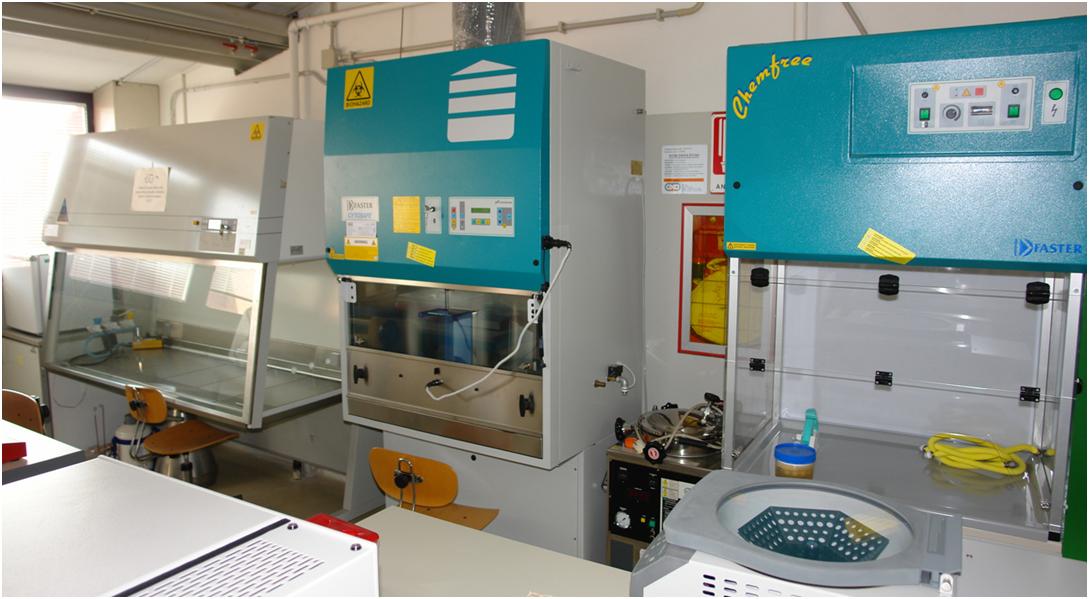
The Laboratory on Implant Infections has been created and is operating at the Rizzoli Orthopaedic Institute as an autonomous research laboratory starting from the year 2000, but the first studies on bacterial adhesion to biomaterials, and on the interactions between microorganisms and materials were introduced at the IOR since 1986, by the current Head of the Laboratory, within the Laboratory on Biocompatibility of Implant Material.
Since its establishment, its main research topics concern the study of the etio-pathogenesis of implant-associated infections, the development of new methods for the characterisation of virulence factors (i.e. biofilm, adhesins, toxins) and antibiotic resistance traits of bacteria responsible for orthopedic infections, the evaluation of coatings and drugs designed to inhibit microbial adhesion, and the assessment of infection-resistant biomaterials.
The research activities of the Laboratory are performed on anti-adhesive drugs or coatings, projected in the Laboratory itself or on new materials proposed by chemists, bioengineers, biomaterials scientists from academic environments, research centers, companies manufacturing materials and other medical devices.
Assays and tests performed on implant materials and other medical devices
The Laboratory on Implant Infections can perform in vitro evaluations on the biocompatibility of implant materials and other medical devices, also in relation to the control of infection risks, as established by the the international guidelines ISO.
The activity is conducted within the RIZZOLI META-LAB centre of the Rizzoli Orthopaedic Institute. In particular, the following types of evaluation can be performed:
In vitro evaluation of the bacterial adhesion on implant materials
The ability of microorganisms to adhere on the surface of biomaterials is currently considered the most important pathogenetic factor of implant-associated infections. The in vitro evaluation of the capability of implant materials and other medical devices to favour or hamper the adhesion of bacteria with respect to reference materials is essential.
The Laboratory can perform the evaluation of bacterial adhesion on biomaterial samples using quantitative techniques based on:
- turbidimetric technique, which measures the microbial population adhered on the biomaterial surface. Adhered bacterial cells are removed from the surface by sonication and quantified by turbidimetric measurements in terms of nephelometric units (NTU), which can be converted in colony forming units (CFU) through the use of calibration curves;
- chemiluminometric technique, which estimates the number of viable bacterial cells adhering on a given surface from the quantity of ATP content (by luciferin-luciferase reaction). The adhering microbial population is quantified in terms of relative light units (RLU), which can be easily converted in CFU using convenient calibration curves. Specific equipment: Luminometer PALL; Modulus II in luminance, fluorescence and absorbance;
- A confocal microscopic exam highlighting, after proper fluorescent colorings, the thickness, morphology and macromolecular composition of the bacterial biofilm (exopolysaccharide, proteins, extra-cellular DNA) molded on the material.
The evaluation of materials and their coatings in order to establish their resistance to infection is performed in every test in comparison to a reference material for positive control, exhibiting the greatest microbial adhesion, and a negative reference control material, resistant to bacterial adhesion.
In case of antiadhesive treatments on a material surface, it is possible to quantitatively evaluate their efficacy by measuring the variations in adhesiveness exhibited by the treatments with respect to the starting unmodified material surface.
The tests can be performed either by using reference ATCC microbial strains or using strains isolated from clinical infections and stored in the strain library of the Laboratory on Implant Infections, selecting each time strains with ad hoc phenotypic and genotypic predetermined characteristics (adhesins, biofilm, toxins, antibiotic resistance traits) and of specific interest in that analysis.
In vitro evaluation of bacterial growth
Materials doped with antimicrobial substances (antibiotics, chitosan, nitrogen oxide) and 'self-sterilising' materials are currently being produced and proposed for clinical use both as additional components of cements for fixation of orthopaedic and odontoiatric implants and as surface treatments of prosthetic devices used in different medical fields (e.g. orthopaedics, dentistry, otorhinolaryngology, cardiovascular, ophthalmology, urology'). The Laboratory is able to assess the antimicrobial activity of cements and resurfaced materials, measuring by luminometry the kinetics of microbial growth with time.
Assays to evaluate the in vitro efficacy of new drugs on strains isolated from periprosthetic infections.
Evaluations are conducted within experimental models, where the pharmaceutical is utilized in concentrations similar to those that it will reach in vitro in the implant site, on strains with a large clonal diffusion.
Assays to evaluate the in vitro biocompatibility of new prosthetic materials and the capability of favoring osteo-integration
Mesenchymal cells from the bone marrow are cultivated on the tested material surface, for the evaluation of the osteoblastic development through the measuring of biochemical differentiation markers (alkaline phosphatase, collagen, osteocalcin) and the activation of the respective genes. The studies focus on the competition between eukaryotes and prokaryotes cells, in relation to the chemical-physical characteristics of the biomaterial.
Services for health institutions: identification of bacterial species and clones
The Laboratory is equipped with a Riboprinter®, an automated system that allows the molecular typing of bacterial strains based on the polymorphisms of the restriction DNA fragments of the operon of the ribosomal DNA. The profile of restriction fragments (ribotype patterns), obtained by Riboprinter® and compared with the pre-existing library patterns of the reference DuPont identification database, permit a rapid and accurate identification to the genus, species and clonal level of whatever isolate, with a confidence greater than 95%.
In particular, the characterisation of the strain enables the evaluation of the clonal origin of the microbial isolates and, thus, provides with a reliable means to discriminate the potential epidemic origin of bacteria isolated from communities: hospital wards, operating rooms, paediatric or geriatric communities.
Among all the Health Services of the Emilia-Romagna Region, the Laboratory on Implant Infections is the only one owning a Riboprinter®, by which is able to perform bacterial identification and clonal characterisation for other health institutions.
